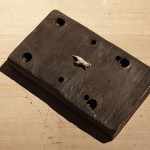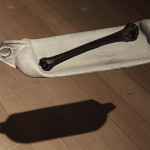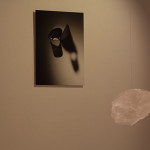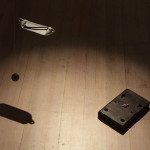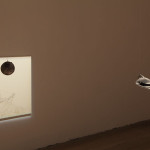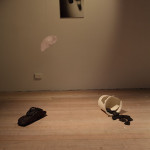List of works
1. Scuttle, Giclee print on Somerset Museum Rag mounted on Di-Bond, 2014, 60x40cm
2. cuttle, Giclee print on Somerset Museum Rag mounted on Di-Bond, 2014, 50x50cm
3. Vessel and Silver, patinated bronze, silver, 2013, 30x45x9cm
4. Vessel and bone, patinated bronze, 2014, 40x10x7cm
5. Untitled (bed and scab), patinated bronze, 2014, 42x12x15
6. Untitled (bucket and gaps), Tengucho tissue paper, polyurethane resin, 2014, 50x23x23
7. Like, lead, 2012, 6x6x6cm
8. Rather, polyurethane resin, 18x6x18cm
Notes around Scuttle (for Subtle)
Scuttle (2013) is a casting of a broken thong hanging off a cast wedge-type object. This suspended moment where the black severed thong precariously perches on the white descent is acted out in the tension between the ‘holed subject’ and the dismembered object. The language of the body clinging to the symbolic is played through the title as scuttle is both a verb of movement as in to scamper or scurry, and the action of intentionally sinking a ship. But as a noun it is a container to hold coal and the opening in a ships deck. This is one of the words with the mark of différance as it plays with the movement between containment and puncturing. Read through the psychoanalytic idea of jouissance, it is the text that fractures the subject. Scuttle is concerned with this encounter of the vessel with the hole or wound; the body that is ruptured, pierced.
Scuttle cast in bronze, attached to a wall is not here (or there), however Scuttle the photographic object is attached to the wall with a single spot light directed at it from the side. Scuttle is a name given to a collection of objects and images that defer to this absent or lost object—the fragments of the vessel without origin—perpetually trying to piece itself back together (the imaginary origin). These pieces weave through and propose traces of the signifier scuttle. This signifier came before, but it also comes after; it is not here, it is always elsewhere. This may be Derrida’s cinder ‘that figures, and because there is no cinder here, not here (nothing to touch, no body, only words)… they name one thing in place of another… one thing while figuring another from which nothing figurable remains’.[1]
The amphora, a vessel of words, the translation that is dislocated in the act of translation, the impossibility of the original all imagine the vessel in fragments as a metonymic play of language. In Paul de Man’s conception, the vessel is untranslatable as it constantly remakes another image in the afterlife of what came before. Amongst the Scuttle objects (or objects scuttled), there are two vessels that act as respective supports for cast animal bones. They transport these bones concurrently as the vessel is itself transposed from another sign system—cast industrial objects. These material objects in bronze and silver belie their physical properties as they refer to past events and another life, while postulating future possibilities through material and image transposition.
What are the possibilities for writing objects that undo themselves; objects that are perpetually in deferment, that are in a constant state of being written, rewritten and overwritten? The objects of this provisional grouping around the word ‘scuttle’, are in production, sliding, reversing, contesting presumed origins and notions of completeness. The gap in the cast thong, or the shadow of the gap in the cast thong derived from the photograph made into resin pieces spilling from a cast broken bucket is the compulsion to repeat the loss; the image-repertoire trying to fill the gap, to return to a prior state that can never be fulfilled. This is the writing of the convulsed text as Hal Foster notes: ‘The veiled-erotic, or reality convulsed into writing, is a photographic effect, but fundamentally it concerns an uncanny trace of a prior state’.[2] This uncanny trace is the bleached out photograph of a landscape that becomes cuttle (2014); for it is always missing something that is a part of another object, another text, another signifier.
Clustering around the signifier ‘scuttle’, pointing to inconclusive referents, this grouping of objects and images induces a seeking of and for itself; ‘the pleasure of the text’. Yet, just as Barthes postulated, the Text that goes beyond pleasure to affect a collapse of the unified subject enters the realm of jouissance. These objects suggest the tracings of an outline that cannot be contained in the symbolic as the scraps of the real are imagined. The transference as an affect of binding the subject through the image-repertoire makes this exercise a fantasmatic one, yet one of necessity as the drives compel a movement; the search as the cause of desire. Objet petit a is that excess of energy that cannot be accommodated or put to rest. This can also be understood through Kristeva’s idea of the semiotic: the disruptive potential of the genotext as it draws on the semiotic chora, the tie with the pre-linguistic infant stage of the subject as moments of bodily rupture.
The movement of the text in Scuttle thus functions on several levels as it implicates the body in the writing of the cast severed object that taps into the subconscious fear of slipping; of the falling subject in a constant state of undoing. Just as the objects undergo a shifting of materiality, they concurrently generate a textualised subject that is manifest in the choice and combination of these derived objects, for example the transposition of a rubber thong into bronze. Scuttle generates a material movement that cannot leave the body of the reader intact. It is playing out this very scuttling of the unified subject through language and material form; a fragmentation of the subject’s body.
The body of the reader as writer is transferred to another paired object, Untitled (Bed and scab), (2014). Another cast thong lies on top of what may be a rock or a piece of sponge from a cheap foam mattress. It follows the contour of the object to which it could be marooned or designed to snugly fit. However, this cast thong has a large scab like element on the piece where a heel would rest in another life. This casting normally discarded as a ‘mistake’ nestles into another broken fragment from a vessel; this one, the bed to which we cannot rest.
In Subtle the object cast in bronze is not there, or at least not there in its physical form. Rather it appears as a photographic representation, Scuttle (2014). However Scuttle is not a single object (or image), nor is it assigned to a particular referent. Scuttle is a word that undoes itself as it undoes the objects that are in a temporary combination for the exhibition Subtle. Scuttle cannot exist in any knowable form, it vacillates between containment and rupture, and thus the objects that weave this web around scuttle are variously derived, damaged, reimaged, remade, imagined and written. Three of them are suspended; Like, Rather, Vessel and Bone. The ‘readymade shadows’ cast by there suspension generate other objects that form a composition mythologised so easily by photography: the ‘that-has-been’ can cast long shadows as Barthes may enunciate. The shadow of Like (2012) falls on the cast paper bucket as the shadow of lead defers the impact of a displaced materiality. This shadow is not so easily legible, whereas, Rather (2012) and Vessel and Bone (2014), make other image objects that constitute a figured deferment on the floor of the space; a production of image writing.
Scuttle (a fragment)
A section has been excised from the sole of a thong, severing it in half. This sliced out section of about 4 cm would completely dismember the thong were it not for the straps that connect the two halves together. This gap, the missing piece of the thong is the element that cannot be filled. It is neither bronze nor rubber.
The white wedge object protrudes from the wall, its chalky texture conflates its physicality with the wall surface; a shift made congruent through a shadow that meshes the two surfaces. This shadow from the top point of the wedge as it is positioned against the wall creates another triangle shape that flows down the wall into what can only be called a distortion in the sense that something has been stretched (not unlike those fairground mirrors that stretch and distort the human body). Yet this shadow breaks into a kind of doubled shadow; two tones of shadow offset. At this point the gap in the cast thong is pronounced as a separation of both object and shadow, so much so that the shadow when momentarily taken in isolation becomes an independent object; an object that is itself situated in this gap between indexicality and an excised symbolic from the real.
Just as jouissance is constituted by a lack, a lack that cannot be accumulated, the gap in the shadow is that ‘leftover of the Real which holes the Symbolic (in conjunction with the Imaginary).'[3] This shadow gap, or the real hole in the Other functions in confounding ways—as the enjoyment of the lack that is impossible to enjoy as the lack is no-thing. This is Lacanian jouissance circumscribing the pain beyond pleasure to which Barthes seeks in the Text that ruptures the reader, the Text that causes a shudder and displacement of the subject. That moment where the text can dismember the subject is not one that can be recuperated, described as such or imaged photographically. But if there is a sense of its future trace and possibility, it is that part of the shadow that is not the shadow; a cinder.
This shadow with the disfigured space where a gap appears (also the toe hole in Whenever, 2013), the rubber of the mould that makes the piece to be joined to the body an imprint made from rubber doubled or duplicated as the model inverts into mould. The text that may scuttle the real object is the workings of objet petit a; marking the void. That precarious space where the subject is reminded of their always-already lost unity. That remainder, the scrap that is a trace of the real, always inciting the subject to a return; a perpetual search for the object cause of desire.
[1]Jacques Derrida and Ned Lukacher, Cinders (Lincoln: University of Nebraska Press, 1991), 71.
[2]Hal Foster, Compulsive Beauty (Cambridge, Mass.: MIT Press, 1993), 27.
[3]Lorenzo Chiesa, Subjectivity and Otherness : A Philosophical Reading of Lacan, Short Circuits (Cambridge, Mass.: MIT Press, 2007), 185.


